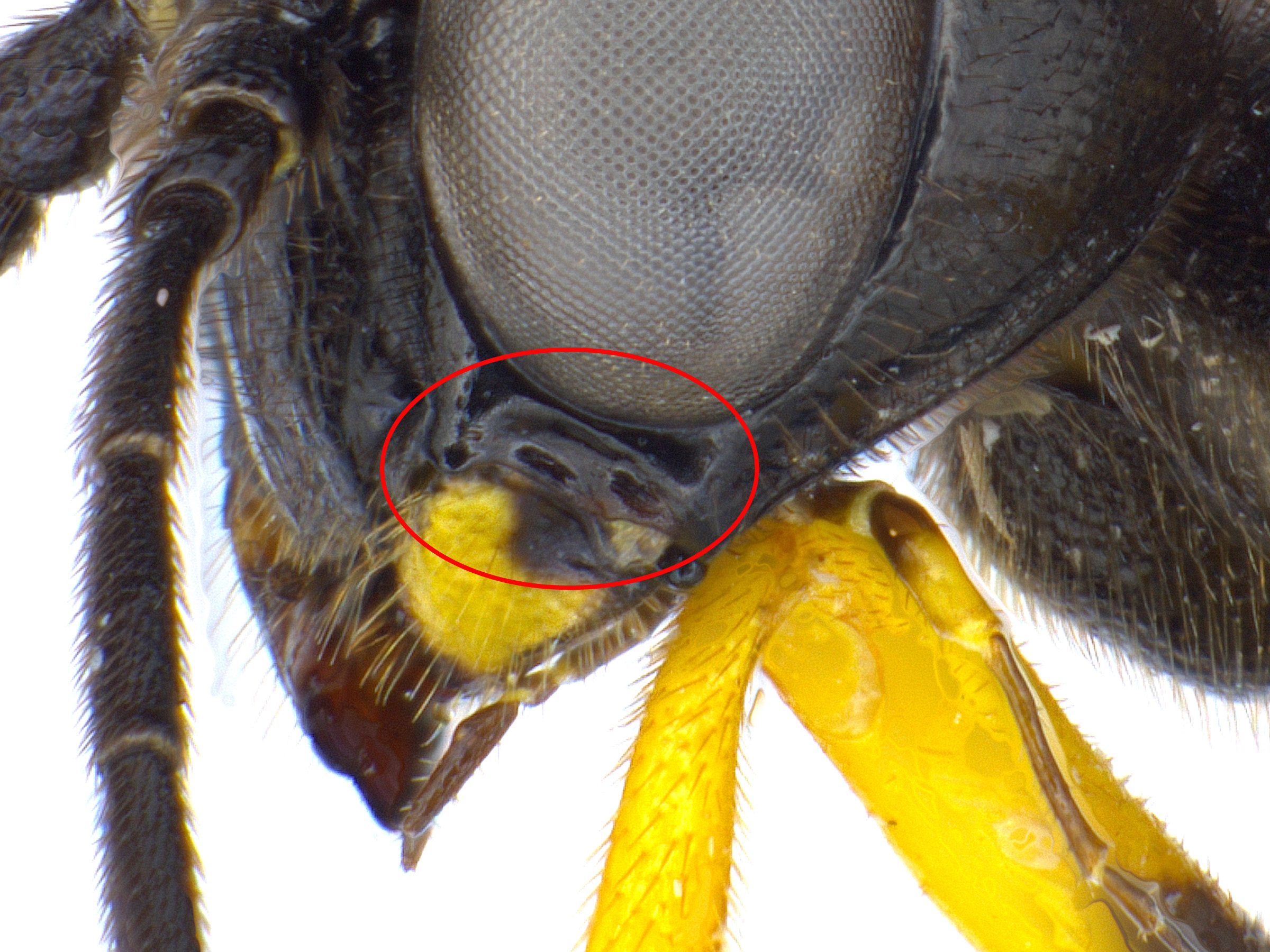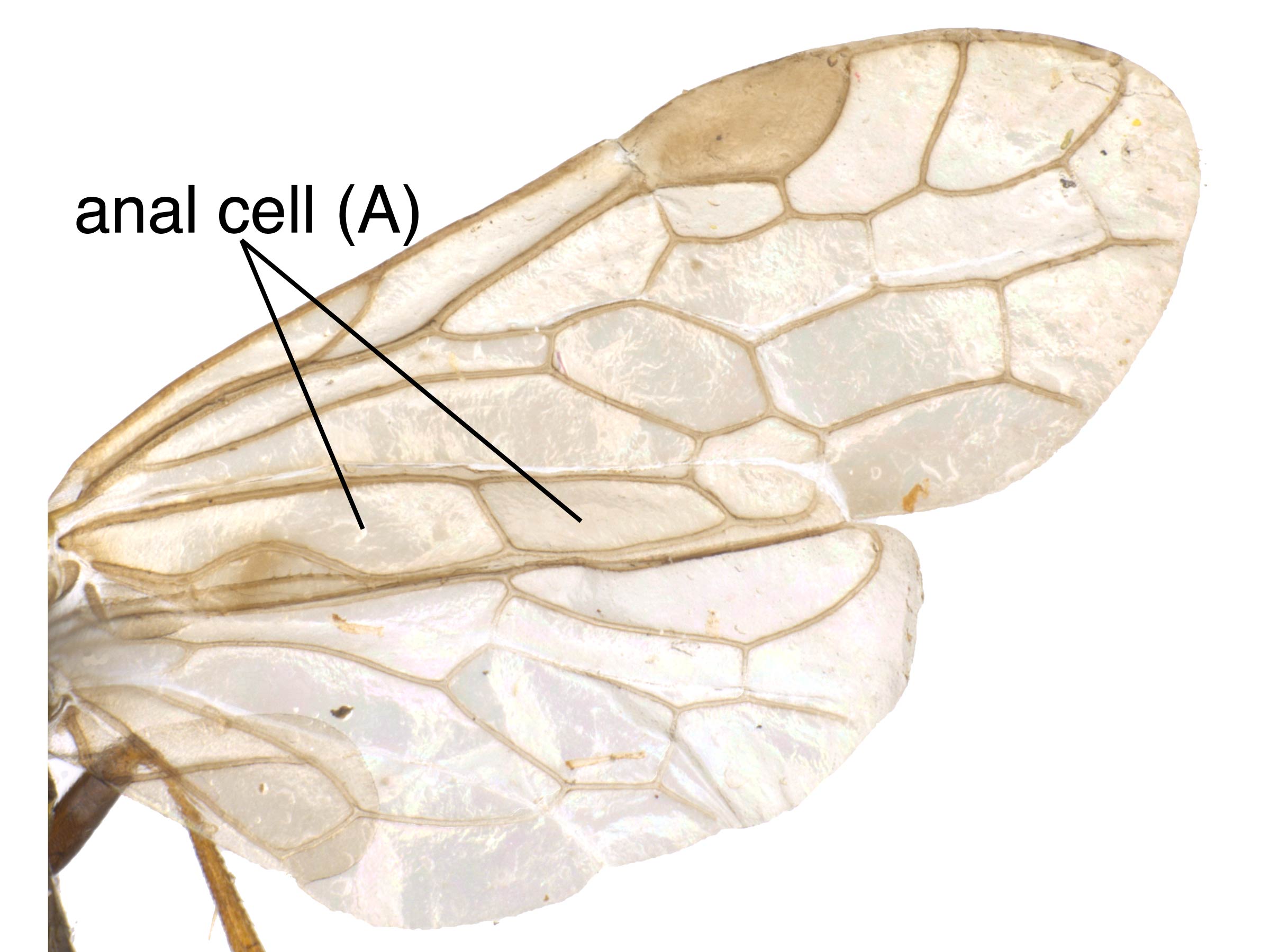Family: Tenthredinidae
Family common name: common sawflies
Subfamily: Heterarthrinae
Tribe: Caliroini
Genus: Caliroa Costa, 1859
Subgenera: none
The Tenthredinidae are the most species-rich family and are found throughout the world, in all continents but Antarctica. They are known as the “common sawflies.” They can generally be recognized by a cylindrical body and long, segmented antennaeantenna:
the sensory organ emerging from the front of the head, usually between the compound eyes and above the clypeus; includes the flagellum, scape and pedicel
 . Otherwise, they come in a variety of colors, sizes, and forms (Goulet 1992Goulet 1992:
. Otherwise, they come in a variety of colors, sizes, and forms (Goulet 1992Goulet 1992:
Goulet H. 1992. The genera and subgenera of the sawflies of Canada and Alaska: Hymenoptera. Symphyta. The insects and arachnids of Canada. Part 20. Agriculture Canada Publication.).
Sawflies in the Heterarthrinae subfamily are generally small and dark-colored. Many species of this family are economic pests of trees and shrubs and can be characterized by their skeletonizing or leaf-mining larval feeding behaviors. Heterarthrinae adults can be distinguished from those of other subfamilies by wing venationvenation:
the network of veins on a wing
(Smith 1971aSmith 1971a:
Smith DR. 1971a. Nearctic Sawflies. III. Heterarthrinae: Adults and larvae (Hymenoptera: Tenthredinidae). Technical Bulletin, U.S. Department of Agriculture 1420: 1-84.).
Caliroa is a species-rich genus found throughout the world. Most species are small, about 4.5–5 mm in length, and mostly black, often with pale-colored legs (Smith 1971aSmith 1971a:
Smith DR. 1971a. Nearctic Sawflies. III. Heterarthrinae: Adults and larvae (Hymenoptera: Tenthredinidae). Technical Bulletin, U.S. Department of Agriculture 1420: 1-84.). Unlike other genera in the subfamily, Caliroa and Endelomyia are external leaf feeders and not leaf miners (Goulet 1992Goulet 1992:
Goulet H. 1992. The genera and subgenera of the sawflies of Canada and Alaska: Hymenoptera. Symphyta. The insects and arachnids of Canada. Part 20. Agriculture Canada Publication.).
There are 71 described extantextant:
in existence; opposite of extinct
species. Sixteen species occur in North America (Taeger et al. 2018Taeger et al. 2018:
Taeger A, Liston AD, Prous M, Groll EK, Gehroldt T, and Blank SM. 2018. ECatSymmdash;Electronic World Catalog of Symphyta (Insecta, Hymenoptera). Program version 5.0 (19 Dec 2018), data version 40 (23 Sep 2018). Senckenberg Deutsches Entomologisches Institut (SDEI), Muuml;ncheberg. https://sdei.de/ecatsym/ Accessed: 28 Jan 2020.).
An incomplete key to species is included in Smith 1971aSmith 1971a:
Smith DR. 1971a. Nearctic Sawflies. III. Heterarthrinae: Adults and larvae (Hymenoptera: Tenthredinidae). Technical Bulletin, U.S. Department of Agriculture 1420: 1-84..
Subfamily characters
 M slightly constricted at apexapex:
M slightly constricted at apexapex: vein 2r present (Goulet 1992Goulet 1992:
vein 2r present (Goulet 1992Goulet 1992:Genus characters
 length about 0.1–0.2X diameter of antennal socket (Goulet 1992Goulet 1992:
length about 0.1–0.2X diameter of antennal socket (Goulet 1992Goulet 1992: veins 2A and 3A complete; complete anal cellanal cell:
veins 2A and 3A complete; complete anal cellanal cell: present (Goulet 1992Goulet 1992:
present (Goulet 1992Goulet 1992: anal cellanal cell:
anal cellanal cell: with an angled crossveincrossvein:
with an angled crossveincrossvein: vein M curved near intersection with M+Cu (Goulet 1992Goulet 1992:
vein M curved near intersection with M+Cu (Goulet 1992Goulet 1992: with anal cellanal cell:
with anal cellanal cell: petiole very short or absent (Smith 1967cSmith 1967c:
petiole very short or absent (Smith 1967cSmith 1967c: with large basalbasal:
with large basalbasal:Caliroa can easily be distinguished from other genera in the subfamily by the complete anal cellanal cell:
cell A of either the fore wing or hind wing
 with crossveincrossvein:
with crossveincrossvein:
short section of wing vein that connects two larger veins
, number of antennal segments, and narrow malar spacemalar space:
the minimum distance between the base of the mandible and the ventral margin of the compound eye
 (Goulet 1992Goulet 1992:
(Goulet 1992Goulet 1992:
Goulet H. 1992. The genera and subgenera of the sawflies of Canada and Alaska: Hymenoptera. Symphyta. The insects and arachnids of Canada. Part 20. Agriculture Canada Publication.). It can be confused with the similar genus Endelomyia, but is distinguished by the apicalapical:
towards the apex; farthest away from the body
flagellomeres (Smith 1967cSmith 1967c:
Smith DR. 1967c. A review of the subfamily Heterarthrinae in North America (Hymenoptera: Tenthredinidae). Proceedings of the Entomological Society of Washington 69: 277-284.).
Caliroa nara in Japan is recorded as a pest defoliating several species of oak (Hara 2011Hara 2011:
Hara H. 2011. A new slug sawfly, Caliroa nara sp. nov. (Hymenoptera, Tenthredinidae), infesting oak trees, with taxonomic notes on C. angustata and C. annulipes . Japanese Journal of Systematic Entomology 17 (2): 369-383.). Caliroa matsumotonis is a pest in Japan and Korea on peach and pear trees (Hara and Shinohara 2013Hara and Shinohara 2013:
Hara H and Shinohara A. 2013. A slug sawfly, Caliroa matsumotonis (Hymenoptera: Tenthredinidae), injurious to peach and pear trees in Japan and Korea. Applied Entomology and Zoology 48 (3): 379-386.).
Caliroa cerasi is a common pest of agricultural significance. Though its common name is “pear slug,” the species has several hosts and is responsible for severe defoliation of agricultural and ornamental plants (Raffa and Lintereur 1988Raffa and Lintereur 1988:
Raffa KF and Lintereur GL. 1988. New host records and developmental notes on the pear slug Caliroa cerasi (Hymenoptera: Tenthredinidae), feeding on Cotoneaster and Chaenomeles species. The Great Lakes Entomologist 21 (2): 75-80.). The “slug” part of the common name comes from the larval form being long, slimy, and shining (Miles 1935Miles 1935:
Miles HW. 1935. Biological studies of certain species of Caliroa Costa and Endelomyia Ashmead (Hymenoptera Symphyta). Annals of Applied Biology 22 (1): 116-133. https://doi.org/10.1111/j.1744-7348.1935.tb07712.x). The species is usually bivoltinebivoltine:
describing a life cycle with two generations per calendar year
in North America (Smith 1971aSmith 1971a:
Smith DR. 1971a. Nearctic Sawflies. III. Heterarthrinae: Adults and larvae (Hymenoptera: Tenthredinidae). Technical Bulletin, U.S. Department of Agriculture 1420: 1-84.). This species has spread via exportation of wood and fruit products and is invasive and established in Australia, South America, and South Africa (Koch and Smith 2011Koch and Smith 2011:
Koch F and Smith DR. 2011. A new species of Caliroa (Hymenoptera: Tenthredinidae) from South Africa. Proceedings of the Entomological Society of Washington 113 (4): 442-450. http://dx.doi.org/10.4289/0013-8797.113.4.442).
Caliroa quercuscoccineae is a pest of red oak responsible for infestations defoliating more than 1.5 million acres of trees in a single year. Recent years have seen a decrease of outbreaks of this species (Nordin and Johnson 1983Nordin and Johnson 1983:
Nordin GL and Johnson EL. 1983. Biology of Caliroa quercuscoccineae (Dyar) (Hymenoptera: Tenthredinidae) in Central Kentucky I. Observations on the taxonomy of principal life stages. Journal of the Kansas Entomological Society 56 (3): 305-314.).
Caliroa in North America feeds on a variety of plants including species of Quercus (oak), Nyssa (tupelo), Castanea (chestnut), Pyrus (pear), Prunus (cherry, plum), Sorbus (mountain ash), Malus (apple), Salix (willow), Cotoneaster, and Chaenomeles (flowering quince) (Raffa and Lintereur 1988Raffa and Lintereur 1988:
Raffa KF and Lintereur GL. 1988. New host records and developmental notes on the pear slug Caliroa cerasi (Hymenoptera: Tenthredinidae), feeding on Cotoneaster and Chaenomeles species. The Great Lakes Entomologist 21 (2): 75-80., Goulet 1992Goulet 1992:
Goulet H. 1992. The genera and subgenera of the sawflies of Canada and Alaska: Hymenoptera. Symphyta. The insects and arachnids of Canada. Part 20. Agriculture Canada Publication., Smith 2003bSmith 2003b:
Smith DR. 2003b. A Synopsis of the sawflies (Hymenoptera: Symphyta) of America south of the United States: Tenthredinidae (Nematinae, Heterarthrinae, Tenthredininae). Transactions of the American Entomological Society 129 (1): 1-45.). Caliroa dionae feeds on Vaccinium corymbosum (highbush blueberry) (Smith and Moisan-De Serres 2017Smith and Moisan-De Serres 2017:
Smith DR and Moisan-De Serres J. 2017. A new North American Caliroa (Hymenoptera: Tenthredinidae) on Vaccinium corymbosum L. (Ericaceae). Proceedings of the Entomological Society of Washington 119 (4): 637-640. https://doi.org/10.4289/0013-8797.119.4.637).
Females oviposit into the surface of the leaf, along the midrib or a main veinvein:
a tube-like, often darkened, structure on the wings
 . LarvaeLarva:
. LarvaeLarva:
the immature stage of holometabolous insects
 feed gregariously for a few weeks on the inter-vein tissue, skeletonizing the leaf. At maturity, the larvaelarva:
feed gregariously for a few weeks on the inter-vein tissue, skeletonizing the leaf. At maturity, the larvaelarva:
the immature stage of holometabolous insects
 drop to the ground and pupate or overwinter. Many species are multivoltinemultivoltine:
drop to the ground and pupate or overwinter. Many species are multivoltinemultivoltine:
describing a life cycle with many generations per calendar year
(Smith 1971aSmith 1971a:
Smith DR. 1971a. Nearctic Sawflies. III. Heterarthrinae: Adults and larvae (Hymenoptera: Tenthredinidae). Technical Bulletin, U.S. Department of Agriculture 1420: 1-84.).
World: This genus is represented in every continent except Antarctica. Species range throughout North America, South America, Europe, Japan, and China, and occur in Indonesia, Australia, and South Africa (Smith 2003, Koch and Smith 2011Koch and Smith 2011:
Koch F and Smith DR. 2011. A new species of Caliroa (Hymenoptera: Tenthredinidae) from South Africa. Proceedings of the Entomological Society of Washington 113 (4): 442-450. http://dx.doi.org/10.4289/0013-8797.113.4.442).
North America: Caliroa occurs throughout the United States and southern Canada, with some records in Mexico (Smith 1971aSmith 1971a:
Smith DR. 1971a. Nearctic Sawflies. III. Heterarthrinae: Adults and larvae (Hymenoptera: Tenthredinidae). Technical Bulletin, U.S. Department of Agriculture 1420: 1-84., Smith 2003).
Map data from: GBIF.org (29 October 2019) GBIF Occurrence Download Caliroa
Details about data used for maps can be found here.